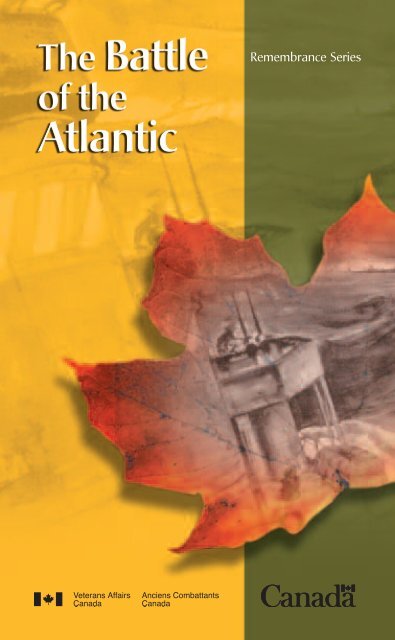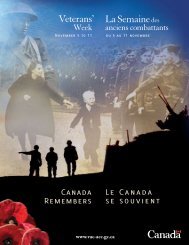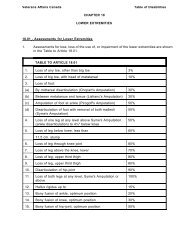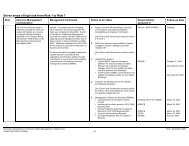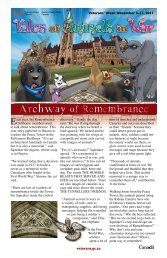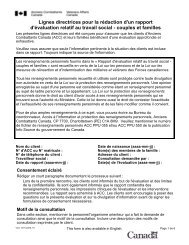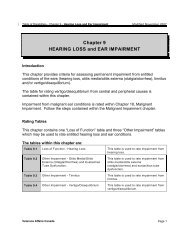You also want an ePaper? Increase the reach of your titles
YUMPU automatically turns print PDFs into web optimized ePapers that Google loves.
Remembrance Series
<strong>The</strong> <strong>Battle</strong> <strong>of</strong> <strong>the</strong> <strong>Atlantic</strong>Produced byVeterans Affairs CanadaWritten by Patricia GieslerPhotographs: Courtesy <strong>of</strong> Library and Archives Canada (LAC)and <strong>the</strong> Canadian War Museum (CWM).Cover: <strong>Atlantic</strong> Convoy, painting by Leonard Brooks,courtesy <strong>of</strong> <strong>the</strong> Canadian War Museum.© Her Majesty <strong>the</strong> Queen in Right <strong>of</strong> Canada representedby <strong>the</strong> Minister <strong>of</strong> Veterans Affairs, 2005.Cat. No. V32-71/2005ISBN 0-662-69037-0
<strong>The</strong> <strong>Battle</strong> <strong>of</strong> <strong>the</strong> <strong>Atlantic</strong>Generations <strong>of</strong> Canadians have served our country and <strong>the</strong> world during times <strong>of</strong>war, military conflict and peace. Through <strong>the</strong>ir courage and sacrifice, <strong>the</strong>se menand women have helped to ensure that we live in freedom and peace, while als<strong>of</strong>ostering freedom and peace around <strong>the</strong> world. <strong>The</strong> Canada Remembers Programpromotes a greater understanding <strong>of</strong> <strong>the</strong>se Canadians’ efforts and honours <strong>the</strong>sacrifices and achievements <strong>of</strong> those who have served and those who supportedour country on <strong>the</strong> home front.<strong>The</strong> program engages Canadians through <strong>the</strong> following elements: national andinternational ceremonies and events including Veterans’ Week activities, youthlearning opportunities, educational and public information materials (includingon-line learning), <strong>the</strong> maintenance <strong>of</strong> international and national Government <strong>of</strong>Canada memorials and cemeteries (including 13 First World War battlefieldmemorials in France and Belgium), and <strong>the</strong> provision <strong>of</strong> funeral and burial services.Canada’s involvement in <strong>the</strong> First and Second World Wars, <strong>the</strong> Korean War, andCanada’s efforts during military operations and peace efforts has always beenfuelled by a commitment to protect <strong>the</strong> rights <strong>of</strong> o<strong>the</strong>rs and to foster peace andfreedom. Many Canadians have died for <strong>the</strong>se beliefs, and many o<strong>the</strong>rs havededicated <strong>the</strong>ir lives to <strong>the</strong>se pursuits. This willingness to stand up to protecthuman rights, freedom and justice remains one <strong>of</strong> Canada’s definingcharacteristics in <strong>the</strong> eyes <strong>of</strong> <strong>the</strong> world.Veterans Affairs Canada encourages all Canadians to learn more about <strong>the</strong>sacrifices and achievements made by those who served our country, andto help preserve <strong>the</strong>ir legacy by passing <strong>the</strong> torch <strong>of</strong> remembrance t<strong>of</strong>uture generations <strong>of</strong> Canadians....To you from failing hands we throw <strong>The</strong> torch, be yours to hold it high. If ye breakfaith with us who die We shall not sleep, though poppies grow In Flanders fields.From “In Flanders Fields” by John McCraeFor a list <strong>of</strong> all publication titles available, please visit www.vac-acc.gc.caor call 1-877-604-8469 toll free.
Introduction“What a miserable, rotten hopeless life... an <strong>Atlantic</strong> so roughit seems impossible that we can continue to take this unendingpounding and still remain in one piece... hanging onto aconvoy is a full-time job... <strong>the</strong> crew in almost a stupor from <strong>the</strong>nightmarishness <strong>of</strong> it all... and still we go on hour after hour.”Frank Curry <strong>of</strong> <strong>the</strong> Royal Canadian Navy (RCN) wrote <strong>the</strong>sewords in his diary aboard a corvette in 1941, during <strong>the</strong> <strong>Battle</strong><strong>of</strong> <strong>the</strong> <strong>Atlantic</strong>, a battle that would be called <strong>the</strong> longest <strong>of</strong> <strong>the</strong>Second World War. During <strong>the</strong> darkest days <strong>of</strong> <strong>the</strong> war, thousands<strong>of</strong> Canadians in <strong>the</strong> RCN, <strong>the</strong> Canadian Merchant Navy, and<strong>the</strong> Royal Canadian Air Force (RCAF) faced perilous conditionsthat many <strong>of</strong> us can only imagine. <strong>The</strong> following account tellsa tale <strong>of</strong> incredible bravery and sacrifice which all <strong>of</strong> us havea duty not only toremember but topass along to futuregenerations.HMCS BRANTFORD COVERED WITH ICE, FEBRUARY1944. (LIBRARY AND ARCHIVES CANADA (LAC)PA136146)<strong>The</strong> <strong>Battle</strong> <strong>of</strong><strong>the</strong> <strong>Atlantic</strong>From <strong>the</strong> very outset<strong>of</strong> hostilities in <strong>the</strong>Second World Warin 1939, <strong>the</strong> <strong>Atlantic</strong>supply route fromNorth America to <strong>the</strong>United Kingdom wasthreatened. Eventuallygaining control <strong>of</strong> <strong>the</strong>entire coast <strong>of</strong>3 <strong>The</strong> <strong>Battle</strong> <strong>of</strong> <strong>the</strong> <strong>Atlantic</strong>
CONVOY ASSEMBLED IN THE BEDFORD BASIN, HALIFAX, N.S., APRIL 1942.(LAC PA112993)Europe, from <strong>the</strong> nor<strong>the</strong>rn tip <strong>of</strong> Norway to <strong>the</strong> Pyrenees, <strong>the</strong>Germans set out from every harbour and airfield in westernEurope to sever <strong>the</strong> lifelines to Britain.For six long years <strong>the</strong> RCN, <strong>the</strong> Canadian Merchant Navy and<strong>the</strong> RCAF were central participants in what was to be knownas <strong>the</strong> <strong>Battle</strong> <strong>of</strong> <strong>the</strong> <strong>Atlantic</strong>.<strong>The</strong> sea lanes <strong>of</strong> <strong>the</strong> North <strong>Atlantic</strong> formed a grim battleground.Navigation was hazardous, and sailors in <strong>the</strong> navy and merchantmarine died not only from enemy attack, but from exposureand accidents in <strong>the</strong> fog and winter gales. Nor was protectionsufficient to prevent heavy losses. <strong>The</strong>re were too few navalvessels and maritime patrol aircraft available, as well as a severelack <strong>of</strong> training and modern equipment and technology.<strong>The</strong> <strong>Battle</strong> <strong>of</strong> <strong>the</strong> <strong>Atlantic</strong> 4
In 1939, Canada possessed only a few dozen Canadianregisteredmerchant ships, six destroyers, five small minesweepers,two training vessels, and a single squadron <strong>of</strong> modern militaryflying boats. No one would have predicted that, from this tinybeginning, Canada’s forces would go on to play a large andsignificant part in <strong>the</strong> <strong>Atlantic</strong> war, and that <strong>the</strong> CanadianMerchant Navy would carry cargoes around <strong>the</strong> world.BOATLOAD OF SEAMEN FROM TORPEDOED MERCHANT SHIP COMING ALONGSIDEHMCS RED DEER OFF HALIFAX, 1942. (LAC C54474)Bridging <strong>the</strong> <strong>Atlantic</strong> was <strong>the</strong> key to strategic supply, andit was in maintaining <strong>the</strong> <strong>Atlantic</strong> lifeline that Canadiannaval and air personnel played an increasingly vital role.To transport safely <strong>the</strong> vast amounts <strong>of</strong> goods and troopsthat were needed, ship movements had to be organized andcontrolled. In August 1939, Canadian-registered merchantships and ships in Canadian ports passed from <strong>the</strong> control<strong>of</strong> <strong>the</strong>ir owners into <strong>the</strong> control <strong>of</strong> <strong>the</strong> RCN, which woulddetermine routes and departures. Shipping on <strong>the</strong> more5 <strong>The</strong> <strong>Battle</strong> <strong>of</strong> <strong>the</strong> <strong>Atlantic</strong>
important and vulnerable routes was placed in convoy as<strong>the</strong> best means to regulate traffic and provide protectionfrom both sea and air.TORPEDO EXPLOSION DAMAGE TO PORT LOWER SIDE OF HULL OF SS FORT CAMSUN.(LAC PA190186)On September 16, 1939, <strong>the</strong> first convoy set out from Halifaxfor <strong>the</strong> United Kingdom, closely guarded by HM cruisersBerwick and York and by <strong>the</strong> Canadian destroyers St. Laurentand Saguenay. Soon, two convoys a week were sailing fromHalifax. By <strong>the</strong> end <strong>of</strong> 1939, some 410 ships in 14 HXconvoys had crossed <strong>the</strong> <strong>Atlantic</strong>. Escort work would remain<strong>the</strong> RCN’s chief responsibility for <strong>the</strong> duration <strong>of</strong> <strong>the</strong> war.It was difficult and dangerous work and Canadians shared in<strong>the</strong> worst hardships experienced in <strong>the</strong> war at sea.<strong>The</strong> Early <strong>Battle</strong>sIn April 1940, <strong>the</strong> war in Europe took an ominous turn asGerman troops without warning seized Denmark and launchedan invasion <strong>of</strong> Norway. In only a few weeks <strong>the</strong> Germans hadconquered Denmark and Norway and isolated Sweden.<strong>The</strong> <strong>Battle</strong> <strong>of</strong> <strong>the</strong> <strong>Atlantic</strong> 6
On May 10, Germany launched its blitzkrieg against Holland,Luxembourg, Belgium and France. With German troopspressing from all sides, <strong>the</strong> Allied troops in Europe were forcedto <strong>the</strong> Channel at Dunkirk with <strong>the</strong> sea as <strong>the</strong> only hope <strong>of</strong>escape. On June 22, 1940, France surrendered, and Britainand its dominions stood alone against a formidable enemy.Although <strong>the</strong> United Kingdom proved victorious in <strong>the</strong> <strong>Battle</strong><strong>of</strong> Britain and managed to stave <strong>of</strong>f Hitler’s planned invasion,it remained under siege. London, many British cities and <strong>the</strong>English Channel ports were bombed unmercifully, and <strong>the</strong>U-boats, using <strong>the</strong>ir brand new bases in France, attackedconvoys and independently-routed ships almost at will.<strong>The</strong> U-boats picked <strong>of</strong>f solo ships and stragglers and madebold, single-handed attacks on convoys. <strong>The</strong>se young aces,<strong>the</strong> German elite, raced each o<strong>the</strong>r for tonnage sunk.German naval commanders later referred to <strong>the</strong> periodJuly to September 1940 as "<strong>the</strong> happy time."CORVETTE HMCS KAMSACK IN THE NORTH ATLANTIC, DECEMBER 1943.(LAC PA116963)7 <strong>The</strong> <strong>Battle</strong> <strong>of</strong> <strong>the</strong> <strong>Atlantic</strong>
In September <strong>of</strong> 1940, for <strong>the</strong> first time, U-boats began using<strong>the</strong> so-called "wolf-pack" tactics. At night, groups <strong>of</strong> U-boats(<strong>of</strong>ten as many as six and sometimes more) attacked convoyssailing from North America to Britain. <strong>The</strong> results werecalamitous. As many as 20 per cent <strong>of</strong> a convoy’s heavily-ladencargo ships were sunk.Meanwhile, <strong>the</strong> blitz on London went on night after night toshatter its enormous port. <strong>The</strong> Channel was closed to shippingby October and all <strong>Atlantic</strong> convoys were rerouted north <strong>of</strong>Ireland to Liverpool and <strong>the</strong> Clyde in Scotland. Even thisroute was seriously threatened and four RCN destroyers,which had been stationed in British waters after France wasinvaded, strove to fend <strong>of</strong>f submarine attacks while rescuingsurvivors <strong>of</strong> torpedoed merchant ships.<strong>The</strong> shipping losses were staggering and British shipyards wereheavily committed to naval construction. Great Britain couldnot produce new merchant ships at <strong>the</strong> pace needed to replacethose being lost and turned to <strong>the</strong> United States and Canada.In <strong>the</strong> face <strong>of</strong> <strong>the</strong> urgent need, Canada embarked on a massiveshipbuilding program. However, before <strong>the</strong>se ships could come<strong>of</strong>f <strong>the</strong> assembly lines, <strong>the</strong> <strong>Atlantic</strong> war grew more desperate.<strong>The</strong> War Intensifies – 1941With <strong>the</strong> approach <strong>of</strong> <strong>the</strong> spring <strong>of</strong> 1941, <strong>the</strong> enemy steppedup <strong>the</strong> scale <strong>of</strong> attack. In June alone, more than 454,000tonnes <strong>of</strong> shipping were lost to U-boats.<strong>The</strong> <strong>Battle</strong> <strong>of</strong> <strong>the</strong> <strong>Atlantic</strong> 8
DESTROYER CREW PREPARING LINES FOR OILING AT SEA, NOVEMBER 1942.(LAC PA140087)Although <strong>the</strong> Royal Navy was able to assert its superiority over<strong>the</strong> German surface fleet, <strong>the</strong> menace from German submarinesmounted. <strong>The</strong> U-boats concentrated at weak points in <strong>the</strong> navaldefences <strong>of</strong> <strong>the</strong> Allies. Ships were lost because <strong>the</strong>ir escorts hadreached <strong>the</strong> limits <strong>of</strong> <strong>the</strong>ir endurance and had to turn back.To counteract this menace, new types <strong>of</strong> vessels were constructedand scientists worked desperately to design new methods <strong>of</strong>locating and destroying <strong>the</strong> U-boats. Canada’s fleet was augmentedby several new types <strong>of</strong> vessels, <strong>of</strong> which <strong>the</strong> corvette was <strong>the</strong>most famous. Designed on <strong>the</strong> pattern <strong>of</strong> a whaler, it was63 metres long, displaced 935 tonnes and had a maximum speed<strong>of</strong> 16 knots. <strong>The</strong>y could be produced quickly and cheaply andhad <strong>the</strong> ability to outmanoeuvre a submarine. However, corvetteswere known as "wet ships." <strong>The</strong>y had been designed for coastalpatrols and were pressed into transatlantic service only because<strong>the</strong>re was nothing else available. As <strong>the</strong> seas broke over <strong>the</strong>m,salty water seeped through seams, hatches and ventilators.<strong>The</strong>y were intolerably crowded and living conditions on board9 <strong>The</strong> <strong>Battle</strong> <strong>of</strong> <strong>the</strong> <strong>Atlantic</strong>
for a crew <strong>of</strong> some 60 sailors were terrible. Never<strong>the</strong>less, <strong>the</strong>sesmall ships were invaluable in <strong>the</strong> anti-U-boat war. Of <strong>the</strong>123 corvettes that served in <strong>the</strong> RCN, ten were lost to enemyaction.As enemy U-boats began to probe far<strong>the</strong>r west, <strong>the</strong> Britishcountered by establishing new bases for ships and aircraftin Iceland and Newfoundland. <strong>The</strong> Newfoundland baseswould become a Canadian responsibility. On May 31, 1941,Commodore Leonard Murray, RCN, was appointed commander<strong>of</strong> <strong>the</strong> Newfoundland Escort Force reporting to <strong>the</strong> BritishCommander-in-Chief, Western Approaches. A few days later,<strong>the</strong> first Canadian corvettes joined his command. In June,Canadian destroyers in British home waters returned to servewith <strong>the</strong> Newfoundland force. By July, <strong>the</strong> NewfoundlandEscort Force totalled 12 groups <strong>of</strong> Canadian and Britishwarships and was escorting convoys as far as 35 degrees west.SUPERMARINE FLYING BOAT OF THE RCAF ESCORTING CONVOY, APRIL 1941.<strong>The</strong> <strong>Battle</strong> <strong>of</strong> <strong>the</strong> <strong>Atlantic</strong> 10
<strong>The</strong> Royal Canadian Air Force (RCAF), meanwhile, had beenflying patrols over Newfoundland’s waters and coasts since1939 and <strong>the</strong> first maritime patrol squadron had beenstationed at Gander since 1940. Reinforced by o<strong>the</strong>r RCAFsquadrons, it now provided air support to <strong>the</strong> NewfoundlandEscort Force and was an integral part <strong>of</strong> <strong>the</strong> RCAF’s EasternAir Command. In <strong>the</strong> eastern <strong>Atlantic</strong>, <strong>the</strong> convoys wereguarded by <strong>the</strong> Royal Air Force (RAF) Coastal Commandwhich included RCAF squadrons. At this time, however,aircraft lacked <strong>the</strong> range to cover <strong>the</strong> central part <strong>of</strong> <strong>the</strong> <strong>Atlantic</strong>ocean, an area that became know as <strong>the</strong> “Black Pit” because <strong>of</strong><strong>the</strong> heavy losses <strong>the</strong> U-boats were <strong>of</strong>ten able to inflict <strong>the</strong>re.PERSONNEL HANDLING TORPEDO IN HMC DOCKYARD, HALIFAX. (LAC PA104147)<strong>The</strong> Campaign Moves to North American WatersAlthough <strong>of</strong>ficially neutral, <strong>the</strong> United States had becomeincreasingly involved in <strong>the</strong> war at sea. In September 1941Canadian naval forces came under American "co-ordinatingsupervision." This arrangement replaced control by <strong>the</strong> Britishcommander-in-chief, based in England, with an Americancommander who was much closer to <strong>the</strong> situation in <strong>the</strong>11 <strong>The</strong> <strong>Battle</strong> <strong>of</strong> <strong>the</strong> <strong>Atlantic</strong>
western <strong>Atlantic</strong>. However, when <strong>the</strong> United States <strong>of</strong>ficiallyentered <strong>the</strong> war in December 1941 following <strong>the</strong> Japaneseattack on Pearl Harbor, many <strong>of</strong> <strong>the</strong> American ships werewithdrawn from <strong>the</strong> North <strong>Atlantic</strong> to meet burgeoning U.S.commitments elsewhere. This, unfortunately, weakened <strong>the</strong><strong>Atlantic</strong> anti-submarine defences.As winter storms began to batter <strong>the</strong> convoys, marine casualtiesfrom causes o<strong>the</strong>r than enemy action also rose steadily.<strong>The</strong> <strong>Battle</strong> <strong>of</strong> <strong>the</strong> <strong>Atlantic</strong> 12
SURVIVORS OF TORPEDOED MERCHANT SHIP ABOARD HMCS ARVIDA, ST. JOHN’S,NFLD., SEPTEMBER 1942. (LAC PA136285)In January 1942, <strong>the</strong> <strong>Battle</strong> <strong>of</strong> <strong>the</strong> <strong>Atlantic</strong> shifted to <strong>the</strong>Canadian and American seaboards where Admiral Karl Dönitz,head <strong>of</strong> German U-boat forces, suspected shipping would bepoorly protected. <strong>The</strong> Canadian navy, however, now with morethan two years experience in organizing convoys, immediatelybegan to sail shipping in defended groups. Often <strong>the</strong> onlyprotection available was a single armed yacht. It worked. <strong>The</strong>U-boats soon shifted <strong>the</strong>ir main <strong>of</strong>fensive to <strong>the</strong> US coast and<strong>the</strong> Caribbean where ships were still sailing alone.It became ano<strong>the</strong>r "happy time" for U-boat commandersas <strong>the</strong> U-boats wreaked havoc along <strong>the</strong> American coastline.Night after night submarines rose to <strong>the</strong> surface and picked <strong>of</strong>fmerchantmen at will, many <strong>of</strong> <strong>the</strong>m silhouetted against <strong>the</strong>undimmed lights <strong>of</strong> <strong>the</strong> shoreline. From January to July 1942,nearly 400 ships were sunk for <strong>the</strong> loss <strong>of</strong> only seven U-boats.Through <strong>the</strong> spring <strong>of</strong> 1942, <strong>the</strong> US Navy gradually built upa convoy system, but was dependent on Canadian help.Canadian escorts, reinforced by some Royal Navy ships,13 <strong>The</strong> <strong>Battle</strong> <strong>of</strong> <strong>the</strong> <strong>Atlantic</strong>
ANTI-SUBMARINE GRENADE LAUNCHED INTO THE AIRBY THE CORVETTE HMCS PICTOU DURINGSUBMARINE ATTACK, MARCH 1942. (LAC PA-116838)escorted much <strong>of</strong><strong>the</strong> transatlanticshipping from NewYork north. Thiswas <strong>the</strong> TriangleRun, in which <strong>the</strong>Canadian escortgroups shuttledconvoys betweenNew York orBoston, Halifax,and <strong>the</strong> eastern part<strong>of</strong> Newfoundland,where <strong>the</strong> Canadianand Britishmid-ocean escortgroups took over<strong>the</strong> run to <strong>the</strong>British Isles. O<strong>the</strong>r Canadian warships assisted <strong>the</strong> British andAmericans in protecting <strong>the</strong> valuable tanker traffic from <strong>the</strong>Caribbean.While <strong>the</strong> RCN and RCAF had been able to limit losses <strong>of</strong>f NovaScotia and Newfoundland during <strong>the</strong> first half <strong>of</strong> 1942, <strong>the</strong>re wasstill a very large vulnerable area: <strong>the</strong> Gulf <strong>of</strong> St. Lawrence. <strong>The</strong> hugecommitments on <strong>the</strong> ocean shipping routes, moreover, left very fewaircraft and almost no warships to defend this inland sea. On <strong>the</strong>night <strong>of</strong> May 11, <strong>the</strong> freighters SS Nicoya and SS Leto weretorpedoed <strong>of</strong>f <strong>the</strong> Gaspé Peninsula. <strong>The</strong> war was suddenly right athome and in sight <strong>of</strong> shore.Once again, <strong>the</strong> navy organized convoys and <strong>the</strong> air force kept asmany aircraft overhead as <strong>the</strong>y could. <strong>The</strong>se efforts made <strong>the</strong> great<strong>The</strong> <strong>Battle</strong> <strong>of</strong> <strong>the</strong> <strong>Atlantic</strong> 14
strain on <strong>the</strong> forces nearly unbearable but <strong>the</strong> U-boats continued totake a toll. <strong>The</strong> constricted shipping routes, <strong>the</strong> many deep-waterhiding places, and <strong>the</strong> virtual blindness <strong>of</strong> underwater detectionequipment in <strong>the</strong> complex waters <strong>of</strong> <strong>the</strong> Gulf and river seemed tomake tested defence methods ineffective. By early October, sevenU-boats had sunk two naval escorts and 19 merchant vessels in <strong>the</strong>gulf and river. <strong>The</strong>n, on October 14, <strong>the</strong> ferry Caribou was sunkjust 64 kilometres short <strong>of</strong> her Newfoundland destination.Of 237 passengers, 136 men, women and children perished.15 <strong>The</strong> <strong>Battle</strong> <strong>of</strong> <strong>the</strong> <strong>Atlantic</strong>
A CONSOLIDATED VLR LIBERATOR PROVIDES AIR-COVER FOR A TRANSATLANTICCONVOY. (LAC PA107907)<strong>The</strong> disaster seemed to confirm <strong>the</strong> wisdom <strong>of</strong> <strong>the</strong> navy in itsdecision a few weeks before to close <strong>the</strong> Gulf to overseasshipping. <strong>The</strong> immediate cause for this development had beenyet ano<strong>the</strong>r plea from Britain for more Canadian escorts foryet ano<strong>the</strong>r new commitment — to support <strong>the</strong> Alliedinvasion <strong>of</strong> North Africa. <strong>The</strong>se ships could only be providedby reducing <strong>the</strong> force in Canadian waters, and <strong>the</strong> navalpresence in <strong>the</strong> Gulf was scaled back because <strong>of</strong> <strong>the</strong> problemsencountered in defending against <strong>the</strong> U-boats. Paradoxically, <strong>the</strong>German records now available show that <strong>the</strong> Canadian airforce and navy operations had by October almost completelydiscouraged <strong>the</strong> U-boats. <strong>The</strong> hit on Caribou had been a tragicpiece <strong>of</strong> good luck for a U-boat that had almost given up <strong>the</strong>hunt in <strong>the</strong> Gulf.<strong>The</strong> Grimmest PeriodWhile taking on <strong>the</strong> new responsibilities on <strong>the</strong> NorthAmerican coast and in <strong>the</strong> Mediterranean, <strong>the</strong> RCN also<strong>The</strong> <strong>Battle</strong> <strong>of</strong> <strong>the</strong> <strong>Atlantic</strong> 16
ESCORTING CAPTURED GERMAN U-190 SUBMARINE FROM BAY BULLS TO ST. JOHN’S,NFLD., JUNE 1945. PHOTO BY HAROLD ARTHUR IRISH. (LAC PA140825)maintained a major presence on <strong>the</strong> transatlantic run betweenNewfoundland and Nor<strong>the</strong>rn Ireland. Moreover, <strong>the</strong>y were<strong>of</strong>ten responsible for <strong>the</strong> slowest convoys, <strong>the</strong> ones most likelyto fall victim to U-boat attacks. During <strong>the</strong> summer and fall<strong>of</strong> 1942, as Dönitz scaled back <strong>the</strong> <strong>of</strong>fensive in Canadian andUS waters because <strong>of</strong> improved defences <strong>the</strong>re, he concentratedlarge numbers <strong>of</strong> submarines in <strong>the</strong> mid-<strong>Atlantic</strong>. Despitebombing raids on German construction yards and bases, <strong>the</strong>U-boat force increased. In <strong>the</strong> fall <strong>of</strong> 1942, with nearly300 submarines available - over ten times as many as at <strong>the</strong>outbreak <strong>of</strong> war - Dönitz was able to send 20 or more againsta single convoy.At first <strong>the</strong> Canadian groups held <strong>the</strong>ir own, but as <strong>the</strong> size <strong>of</strong><strong>the</strong> “wolf packs” increased and winter storms swept <strong>the</strong><strong>Atlantic</strong>, several convoys escorted by <strong>the</strong> RCN suffered heavylosses. Canada’s navy had expanded rapidly. By late 1942, <strong>the</strong>RCN had 16,000 members serving in 188 warships, a numberthat was still too few for <strong>the</strong> enormous commitments. <strong>The</strong>strain told in <strong>the</strong> performance <strong>of</strong> <strong>the</strong> Canadian groups, which17 <strong>The</strong> <strong>Battle</strong> <strong>of</strong> <strong>the</strong> <strong>Atlantic</strong>
DEPTH CHARGES BEING DROPPED BY HMCS SAGUENAY. (LAC PA116840)could not be reinforced adequately or supplied with <strong>the</strong> latestweapons or advanced training programs. <strong>The</strong> RCAF’s EasternAir Command did its best to help <strong>the</strong> beleaguered convoyspushing its aircraft to <strong>the</strong> limits. <strong>The</strong> Canadian airmenachieved outstanding results on several occasions, destroyingand damaging U-boats 500 miles and more out in <strong>the</strong> <strong>Atlantic</strong>.<strong>The</strong>y did not, however, have <strong>the</strong> latest “very-long-range”aircraft needed to reach <strong>the</strong> dreaded “Black Pit” where <strong>the</strong>U-boats could attack in relative freedom.<strong>The</strong> <strong>Battle</strong> <strong>of</strong> <strong>the</strong> <strong>Atlantic</strong> reached its climax in March 1943;in that month, <strong>the</strong> U-boats sent 108 Allied ships — 569,000tonnes <strong>of</strong> vital shipping — to <strong>the</strong> bottom. <strong>The</strong>se figures werelower than in November 1942, but what was so disturbingwas that 85 <strong>of</strong> <strong>the</strong> ships lost had been in convoy or stragglingand most had been sunk in <strong>the</strong> North <strong>Atlantic</strong>. <strong>The</strong> onlyglimmer <strong>of</strong> hope lay in <strong>the</strong> success <strong>of</strong> <strong>the</strong> air and naval escortsin exacting a toll <strong>of</strong> 16 U-boats.<strong>The</strong> <strong>Battle</strong> <strong>of</strong> <strong>the</strong> <strong>Atlantic</strong> 18
<strong>The</strong> Tide Turns<strong>The</strong> U-boat success threatened <strong>the</strong> war plans <strong>of</strong> <strong>the</strong> westernalliance. Dependable delivery <strong>of</strong> troops, equipment andsupplies were vital to build up forces for <strong>the</strong> liberation <strong>of</strong>Europe. An all-out Allied effort, especially by <strong>the</strong> British,against <strong>the</strong> submarines was needed. In May 1943, outstandingdefence <strong>of</strong> convoys compelled Dönitz to change his U-boatstrategy in <strong>the</strong> North <strong>Atlantic</strong>.This was not, however, <strong>the</strong> end <strong>of</strong> <strong>the</strong> U-boat menace. Dönitzstill had more than 200 submarines, and German industry andscience was rapidly replacing losses and providing improvedequipment. <strong>The</strong> RCN continued its rapid expansion, but nowwith better equipment and improved ships. For example, largeCanadian-built frigates, unlike <strong>the</strong> little corvettes, were expresslydesigned for trans-ocean escort. <strong>The</strong> RCAF’s Eastern AirCommand also received better aircraft in <strong>the</strong> last half <strong>of</strong> 1943,including very-long-range Consolidated Liberator bombers thatcould - and did - make patrols right across <strong>the</strong> <strong>Atlantic</strong>, helpingto close <strong>the</strong> “Black Pit.” In addition, three RCAF antisubmarinebomber squadrons had been organized in <strong>the</strong> RoyalAir Force’s Coastal Command to carry out patrols from greatFRIGATE HMCS SWANSEA, JANUARY 1944. (LAC PA107941)19 <strong>The</strong> <strong>Battle</strong> <strong>of</strong> <strong>the</strong> <strong>Atlantic</strong>
PAINTING BY JACK NICHOLS. TAKING SURVIVORSON BOARD. (CANADIAN WAR MUSEUM (CWM)10259)Britain. Many RCAFpersonnel also served inBritish anti-submarinesquadrons. Thus <strong>the</strong>RCAF, like <strong>the</strong> RCN,had a major presenceacross <strong>the</strong> whole<strong>Atlantic</strong>. O<strong>the</strong>rtechnologicaldevelopments helped<strong>the</strong> Allied cause aswell, with new weapon,radar and code-breakingdevelopmentscontributing to <strong>the</strong>turning <strong>of</strong> <strong>the</strong> tideagainst <strong>the</strong> U-boats.Both Canadianservices took on an increased share <strong>of</strong> convoy defence in<strong>the</strong> North <strong>Atlantic</strong> to release British warships and aircraftto prepare for <strong>the</strong> Allied invasion <strong>of</strong> France. During <strong>the</strong> lastmonths before <strong>the</strong> Normandy invasion, <strong>the</strong> RCN assumedresponsibility for all North <strong>Atlantic</strong> escort. Canada’s now verysubstantial and capable anti-submarine fleet and air squadronsalso played a prominent part in protecting <strong>the</strong> Allied invasionfleet as it crossed <strong>the</strong> English Channel. Canadian air and navalunits were among <strong>the</strong> most successful among <strong>the</strong> Allied forcesin finding and destroying U-boats during and after <strong>the</strong>invasion.Yet, <strong>the</strong> U-boat fleet continued to launch new <strong>of</strong>fensives. Newsnorkel technology, for example, enabled <strong>the</strong> submarines to<strong>The</strong> <strong>Battle</strong> <strong>of</strong> <strong>the</strong> <strong>Atlantic</strong> 20
HULL 130 THE WINDERMERE PARK AND HULL 131 THE MOUNT BRUCE PARK BEINGCOMPLETED AT DOCKSIDE. (LAC PA187474)operate continuously underwater and allowed <strong>the</strong>m to hoverclose <strong>of</strong>f <strong>the</strong> entrances to British and Canadian ports. Although<strong>the</strong> U-boats were unable to regain <strong>the</strong> initiative, <strong>the</strong>y hadsignificant successes until <strong>the</strong> very end <strong>of</strong> <strong>the</strong> war. A stealthysnorkel U-boat sank <strong>the</strong> minesweeper HMCS Esquimalt just<strong>of</strong>f <strong>the</strong> entrance to Halifax harbour on April 16, 1945.<strong>The</strong> AchievementCanada’s role in <strong>the</strong> <strong>Battle</strong> <strong>of</strong> <strong>the</strong> <strong>Atlantic</strong> was large andsignificant. Starting from a tiny base <strong>of</strong> ships, aircraft andpersonnel, and an infrastructure <strong>of</strong> meagre proportions,Canada became one <strong>of</strong> <strong>the</strong> foremost Allied powers in <strong>the</strong><strong>Atlantic</strong> war. By 1942, Canada was able to carry a majorshare <strong>of</strong> <strong>the</strong> defence <strong>of</strong> North American waters and, at <strong>the</strong> sametime, was Britain’s principal partner in <strong>the</strong> defence <strong>of</strong> transoceanconvoys. By 1944, Canadian forces had developed <strong>the</strong>strength and capability to provide a significant contribution to<strong>the</strong> British and Americans in o<strong>the</strong>r <strong>the</strong>atres <strong>of</strong> <strong>the</strong> war.21 <strong>The</strong> <strong>Battle</strong> <strong>of</strong> <strong>the</strong> <strong>Atlantic</strong>
Canada’s Merchant Navy Veterans bore much <strong>of</strong> <strong>the</strong> brunt <strong>of</strong><strong>the</strong> war in <strong>the</strong> <strong>Atlantic</strong>. Many <strong>of</strong> <strong>the</strong> sailors aboard merchantvessels had survived <strong>the</strong> mines and submarines <strong>of</strong> <strong>the</strong> FirstWorld War and chose to sail again, some two decades later.<strong>The</strong>y sometimes sailed in rusty old ships, but more <strong>of</strong>ten inhighly inflammable tankers or in freighters loaded withammunition. With each voyage <strong>the</strong> odds <strong>of</strong> survival seemed togrow longer. Still, voyage after voyage, men who had beentorpedoed or had seen ships go down about <strong>the</strong>m, sailed andsailed again.<strong>The</strong> most important achievement <strong>of</strong> <strong>the</strong> war in <strong>the</strong> <strong>Atlantic</strong>was <strong>the</strong> more than 25,000 merchant ship voyages made fromNorth American to British ports under <strong>the</strong> escort <strong>of</strong> Canadianforces. <strong>The</strong>se vessels delivered approximately 165 milliontonnes <strong>of</strong> cargo to sustain <strong>the</strong> United Kingdom and madepossible <strong>the</strong> liberation <strong>of</strong> Europe. In <strong>the</strong> process, Canadianwarships and aircraft sank, or shared in <strong>the</strong> destruction <strong>of</strong>some 50 U-boats.Beginning <strong>the</strong> war with a mere 13 vessels and 3,500 personnel,PAINTING BY HAROLD BEAMENT. THERE SHE GOES. (CWM 10067)<strong>The</strong> <strong>Battle</strong> <strong>of</strong> <strong>the</strong> <strong>Atlantic</strong> 22
<strong>the</strong> Royal Canadian Navy grew to become, for a brief time atleast, <strong>the</strong> third largest <strong>of</strong> <strong>the</strong> Allied navies. At war’s end, <strong>the</strong>RCN comprised 373 fighting ships and more than 110,000members, including 6,500 women who served in <strong>the</strong> Women’sRoyal Canadian Naval Services. <strong>The</strong> principal Canadian antisubmarineforces at that time included 261 sea-going escorts(Bangors, corvettes, frigates and escort destroyers). Hundreds <strong>of</strong>o<strong>the</strong>r craft — Fairmile launches, tugboats, coastal tankers and <strong>the</strong>o<strong>the</strong>r kinds <strong>of</strong> transports — protected Canadian waters, serviced<strong>the</strong> fleet and kept <strong>the</strong> bases running. All but a handful <strong>of</strong> <strong>the</strong>RCN ships, moreover, were built in Canada — anaccomplishment <strong>of</strong> critical importance to <strong>the</strong> Allied cause.During <strong>the</strong> dark years <strong>of</strong> 1941 and 1942, when Canadianproduction came on stream, <strong>the</strong> larger Allies simply had no o<strong>the</strong>rsource <strong>of</strong> escorts.<strong>The</strong> RCAF’s Eastern Air Command reached a peak strength <strong>of</strong>21,233 personnel, including 1,735 members <strong>of</strong> <strong>the</strong> Women’sDivision, at <strong>the</strong> end <strong>of</strong> January 1944. Of this total, more than1,200 were air crew. <strong>The</strong> rest managed <strong>the</strong> bases,communications, navigation systems and o<strong>the</strong>r services neededto operate multi-engine aircraft over <strong>the</strong> vast expanse <strong>of</strong> <strong>the</strong>northwest <strong>Atlantic</strong>. At this same time, nearly 2,000 RCAF aircrew were serving in both Canadian and British squadrons <strong>of</strong><strong>the</strong> Royal Air Force Coastal Command.<strong>The</strong> main objective <strong>of</strong> Canada’s <strong>Atlantic</strong> forces was always <strong>the</strong>protection <strong>of</strong> shipping. <strong>The</strong> outcome <strong>of</strong> <strong>the</strong> war was dependenton <strong>the</strong> success <strong>of</strong> <strong>the</strong> <strong>Atlantic</strong> convoys — on <strong>the</strong> merchantships reaching <strong>the</strong> United Kingdom.In 1939, Canada had only 38 ocean-going merchant shipsaveraging little over 6,000 deadweight tonnes, with a total <strong>of</strong>23 <strong>The</strong> <strong>Battle</strong> <strong>of</strong> <strong>the</strong> <strong>Atlantic</strong>
about 290,000 tonnes and manned by approximately1,450 Canadian seamen. Following <strong>the</strong> outbreak <strong>of</strong> war,captured enemy ships and ships <strong>of</strong> occupied nations wereadded to <strong>the</strong> roster. <strong>The</strong>re was also a large Canadian Lakefleet, and in <strong>the</strong> desperate wartime situation even <strong>the</strong>y becameocean-going vessels. Yet, over <strong>the</strong> course <strong>of</strong> <strong>the</strong> next six years,<strong>the</strong> wartime world’s fourth largest merchant navy wouldemerge, almost all <strong>of</strong> it built in Canadian shipyards.<strong>The</strong> number <strong>of</strong> ships that poured from Canada’s shipyards during<strong>the</strong> war was extraordinary. In fact it was described by an <strong>of</strong>ficial <strong>of</strong><strong>the</strong> British Ministry <strong>of</strong> War Transport as "remarkable," "astonishing"and "magnificent." From <strong>the</strong> first delivery in December 1941 toshortly after war’s end in 1945, Canada produced three hundredfifty-four (354) 10,000 tonne dwt cargo ships; forty-three (43)4,700 tonne dwt cargo ships; and six (6) 3,600 tonne dwt cargoship. Simultaneously, <strong>the</strong>y turned out astonishing numbers <strong>of</strong>naval vessels; 281 escort ships (destroyers, corvettes, frigates), 206minesweepers, 254 tugs and 3,302 landing craft.<strong>The</strong> remarkable achievement by <strong>the</strong> Allied shipyards was animportant reason for <strong>the</strong> turn <strong>of</strong> <strong>the</strong> tide in <strong>the</strong> <strong>Battle</strong> <strong>of</strong> <strong>the</strong><strong>Atlantic</strong>. By mid-1943, it was clear that no matter how manymerchant ships German U-boats still could send to <strong>the</strong> bottom,torpedoings could no longer outpace <strong>the</strong> production <strong>of</strong> new ships.<strong>The</strong> Cost <strong>of</strong> WarWith this expanded participation came a high cost. Approximately2,000 members <strong>of</strong> <strong>the</strong> RCN were killed, all causes and <strong>the</strong>atrescombined, <strong>the</strong> vast majority in <strong>the</strong> <strong>Battle</strong> <strong>of</strong> <strong>the</strong> <strong>Atlantic</strong> —752 members <strong>of</strong> <strong>the</strong> RCAF died in maritime operations as a result<strong>of</strong> enemy action and flying accidents in <strong>the</strong> unforgivingenvironment. <strong>The</strong> Book <strong>of</strong> Remembrance for <strong>the</strong> Merchant Navy<strong>The</strong> <strong>Battle</strong> <strong>of</strong> <strong>the</strong> <strong>Atlantic</strong> 24
lists by name nearly 1,600 Canadians and Newfoundlanders, orthose who served on ships <strong>of</strong> Canadian or Newfoundland registry.It includes <strong>the</strong> names <strong>of</strong> eight women. Many o<strong>the</strong>r Canadians,whose names are unknown, were lost serving on ships <strong>of</strong> Alliedmerchant marines.Those who fought in <strong>the</strong> <strong>Battle</strong> <strong>of</strong> <strong>the</strong> <strong>Atlantic</strong> achieved andsacrificed much in <strong>the</strong>ir efforts to help bring peace and freedom to<strong>the</strong> people <strong>of</strong> Europe. <strong>The</strong>se combatants were among <strong>the</strong> morethan one million men and women who served in Canada’s armedforces during <strong>the</strong> Second World War. More than42,000 Canadians gave <strong>the</strong>ir lives in <strong>the</strong> war. Canada recognizes <strong>the</strong>sacrifices and achievements <strong>of</strong> all <strong>the</strong> Canadians, like those wh<strong>of</strong>ought in <strong>the</strong> <strong>Battle</strong> <strong>of</strong> <strong>the</strong> <strong>Atlantic</strong>, who accomplished so muchand left such a lasting legacy <strong>of</strong> peace.<strong>The</strong> <strong>Battle</strong> <strong>of</strong> <strong>the</strong> <strong>Atlantic</strong> was a pivotal struggle that was won, justin time, with massive help from Canada – from its navy, its airmen,its merchant marine and from its civilian population.A Victoria Cross, <strong>the</strong> British Empire’s highest gallantry medal,was posthumously awarded to a member <strong>of</strong> <strong>the</strong> RCAF for hiscourageous leadership during <strong>the</strong> <strong>Atlantic</strong> campaign. FlightLieutenant David Hornell, <strong>of</strong> Mimico, Ontario, was pilot <strong>of</strong>a Canso amphibian aircraft which came across a surfaced U-boatnorth <strong>of</strong> <strong>the</strong> Shetland Islands in June 1944. Although his aircrafthad been hit by anti-aircraft fire, and was burning and vibratingviolently as a result, Hornell managed to destroy <strong>the</strong> sub and land<strong>the</strong> aircraft on <strong>the</strong> water, where it soon sank. Having only one smalldinghy among <strong>the</strong> eight <strong>of</strong> <strong>the</strong> plane’s crew, Hornell gave up hisseat in <strong>the</strong> raft to a wounded crew member. Two Canadians died <strong>of</strong>exposure, and <strong>the</strong> rest were rescued 21 hours after crash-landing.Hornell, blind and exhausted, died shortly after his rescue.25 <strong>The</strong> <strong>Battle</strong> <strong>of</strong> <strong>the</strong> <strong>Atlantic</strong>
Halifax MemorialThis memorial in NovaScotia’s capital, erected inPoint Pleasant Park, is one<strong>of</strong> <strong>the</strong> few tangiblereminders <strong>of</strong> <strong>the</strong>Canadians who died at sea.<strong>The</strong> monument is a greatgranite Cross <strong>of</strong> Sacrificeover 12 metres high,clearly visible to all shipsapproaching Halifax. <strong>The</strong>cross is mounted on a largepodium bearing bronzepanels upon which areinscribed <strong>the</strong> names <strong>of</strong> 3,257 Canadian men and women whowere buried at sea. <strong>The</strong> dedicatory inscription reads as follows:1914 - 1918 1939 - 1945In honour <strong>of</strong> <strong>the</strong> men and women <strong>of</strong> <strong>the</strong> navy, army andmerchant navy <strong>of</strong> Canada whose names are inscribed here.<strong>The</strong>ir graves are unknown but <strong>the</strong>ir memory shall endure.<strong>The</strong> <strong>Battle</strong> <strong>of</strong> <strong>the</strong> <strong>Atlantic</strong> 26


